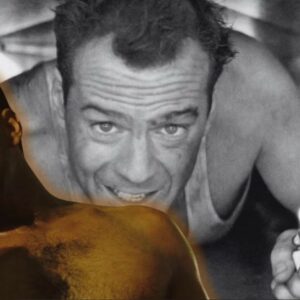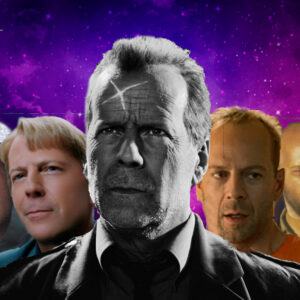Introduction to Their Partnership
The cinematic world of Quentin Tarantino is one of the few arenas where Brad Pitt’s charisma and depth as an actor blend seamlessly with directorial mastery. This partnership, born out of mutual respect for each other’s craft, has not only captivated audiences but also enhanced both their careers. Their collaborations, particularly in “Inglourious Basterds” (2009) and “Once Upon a Time in Hollywood” (2019), reveal a harmony in vision, style, and execution that is rare in Hollywood. For Pitt, the lure of a Tarantino film lies in its unique storytelling and unconventional character arcs. For Tarantino, Pitt represents the consummate actor capable of delivering the emotional nuance and physical presence his stories demand.
Tarantino and Pitt first crossed paths in the late 2000s. By then, Tarantino had already carved a name as an auteur with a knack for resurrecting or redefining actors’ careers, and Pitt was a global star with a rich portfolio spanning from action to drama. Their meeting of minds led to the creation of Lt. Aldo Raine in “Inglourious Basterds” and, later, the unforgettable Cliff Booth in “Once Upon a Time in Hollywood.” Both characters reflect their creative fusion, with Pitt’s rugged charm and intensity bringing Tarantino’s audacious vision to life. Their journey from “Basterds” to “Hollywood” showcases a distinctive relationship between director and actor, marked by mutual respect, admiration, and a shared commitment to crafting iconic performances.
Mutual Admiration and Compatibility
Brad Pitt and Quentin Tarantino’s creative compatibility is rooted in a shared reverence for storytelling. Tarantino is known for his encyclopedic knowledge of film, and Pitt has proven time and again that he possesses an acute understanding of character-driven narratives. This mutual admiration translates into a partnership where each complements the other. Tarantino once noted that Pitt’s ability to fully inhabit his characters added a new dimension to his scripts. Pitt, in turn, has expressed that working with Tarantino is like “getting a license to do your thing,” a rare freedom for an actor in a world where directors often micromanage.
Tarantino’s directorial approach focuses on the actor’s instincts and spontaneity, a style that resonates with Pitt’s preference for organic, in-the-moment performance. Tarantino has often said that Pitt’s raw energy and ability to improvise add authenticity to his characters. This natural ease is especially evident in scenes like the basement tavern confrontation in “Inglourious Basterds” or Booth’s laid-back, almost mythic aura in “Once Upon a Time in Hollywood.” These films required more than just conventional acting—they demanded an ability to embrace complex, often morally ambiguous roles that challenge traditional narratives.
Creative Synergy on Set
The synergy between Tarantino and Pitt becomes most apparent on set, where each leans into the other’s creative impulses. Tarantino’s scripts are famously precise, with a rhythm and dialogue structure that actors are expected to follow meticulously. Yet, within this structure, he grants Pitt an unusual amount of freedom to interpret his characters. This unique mix of direction and autonomy was evident in “Inglourious Basterds,” where Pitt’s portrayal of Aldo Raine involved blending southern swagger with hints of humor, adding layers that made Raine memorable. Tarantino’s decision to let Pitt experiment with the character’s quirks—like his exaggerated Southern drawl—gave the role an edge that has since become iconic.
In “Once Upon a Time in Hollywood,” this collaborative magic reached new heights. Tarantino crafted the character of Cliff Booth with Pitt specifically in mind, seeing him as the embodiment of 1960s coolness and effortless masculinity. Their dynamic was clear during the now-famous fight scene between Booth and Bruce Lee, where Pitt’s relaxed yet intense performance captured both humor and humility. Tarantino’s hands-on direction ensured that the scene struck a balance between homage and satire, while Pitt’s nuanced portrayal helped avoid caricature, instead presenting Booth as both tough and tender—a complicated hero in a nostalgic, golden-era Los Angeles.
Impact on Their Careers
For Pitt, his work with Tarantino has unlocked new creative possibilities, encouraging him to take on roles that blend charisma with dark, gritty undertones. While already an A-lister before “Inglourious Basterds,” his role as Aldo Raine allowed him to delve into the morally complex universe Tarantino often creates. Pitt’s interpretation of Raine brought out a blend of humor, ruthlessness, and heroism that resonated with audiences worldwide, earning him critical acclaim and solidifying his place as one of Hollywood’s most versatile actors. “Once Upon a Time in Hollywood” further cemented his reputation, with his portrayal of Booth earning him an Academy Award for Best Supporting Actor. The role of Booth, arguably one of Pitt’s career-defining performances, reflected the culmination of years of working with Tarantino, allowing Pitt to embrace his character’s vulnerability and strength in equal measure.
For Tarantino, working with Pitt has meant having a trusted collaborator capable of embodying his unconventional characters while adding a touch of humanity. Tarantino has built a reputation for casting actors who are not only stars but who also have a unique magnetism. Pitt’s roles in his films have enhanced Tarantino’s storytelling by adding a layer of realism to his otherwise exaggerated, stylized worlds. The actor’s ability to ground characters in emotional reality, even in the midst of violent or surreal circumstances, has helped shape Tarantino’s narrative style. The director’s penchant for blending humor, tension, and drama finds a perfect match in Pitt, whose versatility brings out the multidimensional nature of Tarantino’s characters.
Legacy and Future Prospects
The collaboration between Brad Pitt and Quentin Tarantino has not only influenced their respective careers but has also left an indelible mark on Hollywood. The success of “Inglourious Basterds” and “Once Upon a Time in Hollywood” speaks to their ability to push the boundaries of mainstream cinema while preserving artistic integrity. Their partnership has inspired a new wave of directors and actors to seek creative risk-taking over commercial safety, a legacy that will continue to shape film culture. Moreover, Pitt’s performances in Tarantino’s films have demonstrated that commercial appeal and depth are not mutually exclusive, a revelation that has likely influenced how leading men approach their roles.
While Tarantino has hinted at retiring after his tenth film, fans of his work hope that Pitt will be involved in any final project he undertakes. The prospect of another collaboration is tantalizing, as both have evolved in their artistry and are unafraid of embracing more daring narratives. Given Tarantino’s penchant for defying expectations, it is likely that he and Pitt could once again surprise audiences, possibly with a story that taps into their collective experience in the industry. Whether or not they collaborate again, the impact of their partnership will remain a testament to the power of synergy between director and actor. It’s a partnership that has not only produced unforgettable cinema but has also elevated the craft, leaving a lasting influence on both mainstream and independent filmmaking.
In an era where Hollywood is constantly evolving, Brad Pitt and Quentin Tarantino’s partnership serves as a reminder of the magic that can happen when creative minds come together, fueled by mutual respect and an unyielding passion for storytelling. Their journey, marked by bold choices, risk-taking, and an unspoken understanding, has given audiences some of the most memorable cinematic moments of the past two decades. Whether on a battlefield in Nazi-occupied France or the sun-drenched streets of 1960s Los Angeles, Pitt and Tarantino have proven that, in the right hands, cinema remains one of the most powerful forms of expression. Their legacy will undoubtedly inspire future generations of filmmakers and actors, solidifying their place as icons in the industry.





